
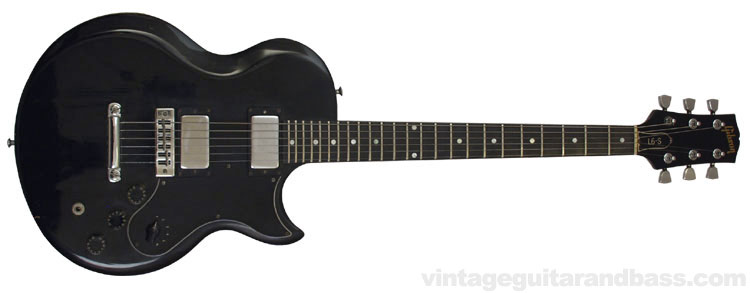
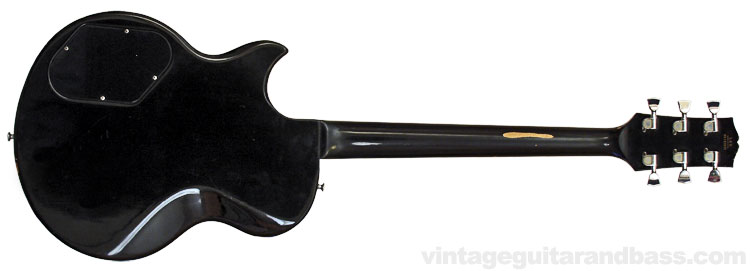
The Gibson L-6S was shipped in relatively large numbers from 1973 until 1979, and then in small numbers into the early 1980s. So this 1976 guitar is right in the middle of its production, and is a typical example. Some 12000 Gibson L6-S guitars were produced between 1973 and 1979, and a third of them were black. This was the second most popular finish for the L-6S, after natural.
The L6-S has a solid maple body and set (glued in) maple neck. The fingerboard is usually maple (for guitars with the natural finish), or ebony, as is the case here, on black guitars. Some earlier and later examples also had rosewood boards.
Hardware is chrome throughout. Schaller M-6 tuning keys, Schaller 'harmonica' tune-o-matic bridge, L-6S humbuckers. All three controls on this guitar were identical 300k CTS pots, dated the 46th week of 1975, part 70029. Despite being stock, there are some minor electrical differences when compared to the published L-6S parts list.
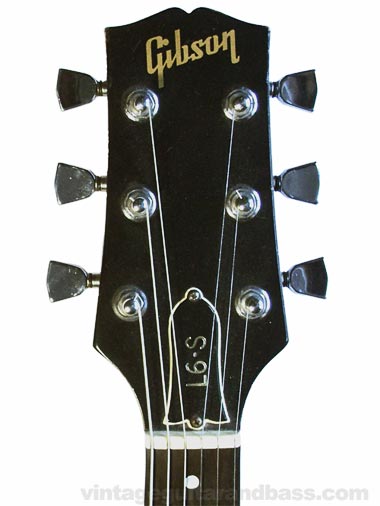
The L-6S had a silk-screened Gibson logo, and model-designated truss rod cover, with revealed edge. The machine heads fitted to this guitar are Schaller M6 with metal buttons, and 'GIBSON' on the gear cover. Note the distinct headstock shape, used on a number of Gibson guitars of this period (but by no means all); wider at the near end than the far end.
The L-6S was fitted with a 1 9/16" molded (Delrin) nut, part 29009.

The decal on the back of the headstock gives the model, 'made in USA' and the serial number. Decal serial numbers were used briefly in the mid 1970s, with the first two digits being a code for the year of manufacture. In this case 00 = 1976. This numbering scheme was gradually replaced by the current system through 1977. Read more about Gibson serial numbers here
Note also the neck volute; the extruding piece of wood where the neck meets the headstock. This feature was widely used on Gibson's maple-necked guitars of the 1970s, primarily to strengthen the area behind the truss-rod cavity. This is a well-known weak spot and was an attempt to avoid neck/headstock breaks.

The L-6S was fitted with two chrome-covered L-6S humbuckers, without adjustable polepieces. Part numbers 13682 (front, neck) and 13683 (back, bridge). They were height adjustable via two screws, one either end of the pickup surround. These pickups were not used on any other Gibson guitar models, except the L-6S Custom and Midnight Special.
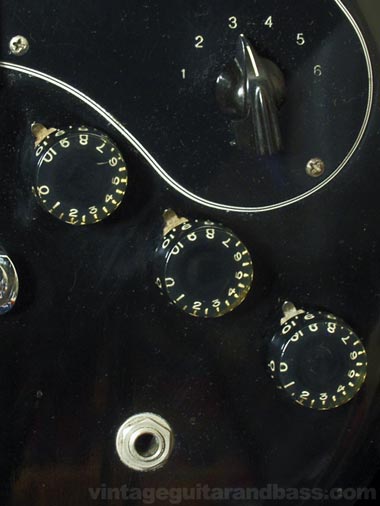
The L-6S controls were devised by Bill Lawrence, and consisted three potentiometers (volume, midrange and tone) and a six-way varitone. Knobs are typical Gibson speed knobs, numbered 0-10; widely used throughout the decade. The six varitone positions are engraved onto the scratchplate. Each position offers a different pickup arrangement and series/parallel and in/out phase options. See the L-6S controls page for details.

Schaller tune-o-matic 'harmonica' bridge and stop tailpiece. These parts were used widely in 1970s Gibson guitars. The L-6S Custom was the only model in the L-6S series not to be strung through the guitar's body.

The neck/body join, body contours and control cavity are all typical Gibson features.
The guitars electronics are accessible with removal of the back panel on the lower left-hand side of the body.
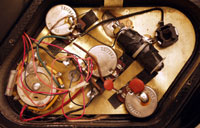
The L-6S custom has three potentiometers and a tone choke (part 70442) See the L6-S schematic
Gibson used a traditional set (glued-in) neck join on the just about all of their guitars until the mid 1970s. The extreme financial pressures of the early/mid 1970s did result in some Gibson solid bodies having a cheaper-to-produce bolt-on neck (e.g. some examples of the L-6S Deluxe and the Midnight Special), but all but the cheapest instruments stuck to Gibson tradition)
The L-6S has quite a wide variety of tones, thanks to the six-way varitone switch, tone and midrange controls. It can be difficult to remember that 'great setting' you found the other day, and it isn't the most intuitive set of controls, but plenty of great sounds are there. Read more about the specifics of each position here. The maple body and neck give it some real bite, especially when compared to the typically warmer mahogany guitars that as so often associated with Gibson. Have a listen to the sound clips below.
This is a great feeling guitar, with a wide range of tones. It's all-maple body and neck, with the ebony fretboard give a bright middy snarly tone. I've had a lot of fun playing with it!
Through a WEM Clubman MK8. All samples recorded with the amp mic'd (Shure SM57) into a M-audio mobile pre USB interface

Through a Marshall Valvestate 8080 - clean channel. All samples recorded with the amp mic'd (Shure SM57) into a M-audio mobile pre USB interface
$2400
$1995
$2100
$315
$1900
$2600
€2490
£1690